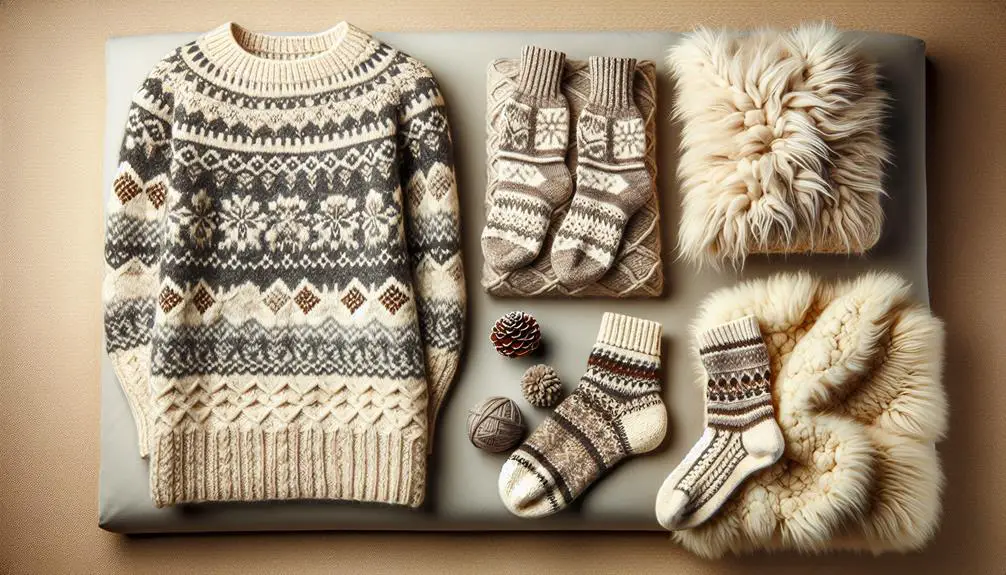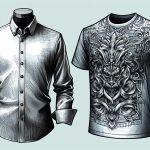I love using wool for clothing because it keeps me warm and comfortable. It's great for T-shirts, hats, scarves, and gloves. Wool is perfect for insulating and making cozy quilts and blankets. Plus, it's ideal for intricate embroidery work. I also use wool for insulation in cold climates because it traps air and reduces the need for extra heating. Wool's luxurious feel and durability make it perfect for upholstery. It's even used in skincare for its moisturizing properties. Wool is the ultimate crafting material, offering unique textures and warmth. Discover more ways to make the most of wool!
Table of Contents
Key Takeaways
- Wool excels in providing superior thermal regulation for clothing and insulation.
- Wool garments offer better warmth and comfort compared to cotton, silk, and polyester.
- Wool is ideal for crafting soft quilts, blankets, and hand embroidery work.
- Wool serves as an exceptional insulator in cold climates, reducing the need for extra heating.
- Wool upholstery fabrics provide luxurious feel, insulation, and temperature regulation benefits.
Clothing
When it comes to clothing, wool excels in providing superior thermal regulation, moisture-wicking abilities, and exceptional durability. Wool garments, including high-end suits, offer better warmth than cotton, silk, and polyester options. The natural properties of wool make it ideal for insulation and comfort, making it a popular choice for T-shirts, shirts, hats, scarves, and gloves.
Moreover, wool fabric is commonly used in crafting soft and warm quilts and blankets, which are sought after for winter bedding due to their cozy feel and excellent heat retention. Woolen yarns, known for their versatility, are also utilized in hand embroidery work, creating intricate designs on various items like floor mats, table cover mats, and other crafts. The durability of wool ensures that these pieces withstand the test of time, providing both functionality and aesthetic appeal in the world of textiles.
Insulation
For ideal warmth in cold climates, wool serves as an exceptional insulator due to its unique ability to retain heat even when wet. Wool's natural thermal regulation properties help keep the body warm in various weather conditions, making it a reliable choice for insulation. The structure of wool fibers creates pockets that trap air, forming a barrier that aids in maintaining body temperature and providing comfort. This insulation capability not only keeps individuals warm but also proves to be energy-efficient by reducing the need for additional heating.
Wool's insulating properties extend its use beyond clothing. It's commonly found in outerwear, bedding, and home insulation due to its superior ability to retain warmth. Whether used in a cozy sweater, a comfortable blanket, or as part of home insulation, wool remains a top choice for those seeking effective and energy-efficient insulation solutions.
Upholstery
Wool upholstery fabrics offer a luxurious feel and excellent insulating properties, making them a popular choice for high-end furniture pieces. Wool is known for its durability, natural fire resistance, and the ability to maintain its shape and appearance over time. It provides a soft texture and a timeless, elegant look to any interior. Wool fibers in upholstery help regulate temperature, ensuring furniture remains comfortable in various climates. Additionally, wool upholstery is a sustainable option as wool is a renewable resource and biodegradable, aligning with environmentally conscious choices.
| Advantages of Wool Upholstery | ||
|---|---|---|
| Luxurious Feel | Excellent Insulation | Sustainable |
| Durability | Fire Resistance | Temperature Regulation |
Skincare
Extracted from wool, lanolin is a common skincare ingredient known for its moisturizing and protective properties. Lanolin is often found in skincare products due to its ability to help guarantee skin moisture and prevent dryness. The natural oils present in wool make it particularly beneficial for sensitive and dry skin types. Wool fibers are hypoallergenic, gentle on the skin, and can reduce the risk of irritation or allergic reactions, making them suitable for those with sensitive skin.
Moreover, wool garments can promote better skin health by allowing the skin to breathe and effectively regulating body temperature. Dermatological testing of wool assures its safety and suitability for various skincare applications. When looking for skincare products that are moisturizing, protective, and gentle on the skin, those containing lanolin extracted from wool can be a natural and effective choice, especially for individuals with sensitive skin concerns.
Crafting
Crafting enthusiasts often turn to wool as their material of choice for its versatility and unique textures in projects like knitting, felting, and weaving. Woolen yarns made of wool are commonly used for creating handmade items such as sweaters, caps, gloves, and various DIY crafts.
The high specific thermal resistance of wool fibers makes them perfect for crafting warm and cozy garments and accessories, providing excellent insulation against the cold. Additionally, wool's durability and long-lasting properties make it a preferred choice for crafting items that require resilience and longevity, ensuring that your creations stand the test of time.
Wool's natural insulating properties also make it an ideal material for crafting quilts, blankets, and other soft furnishings, adding both warmth and style to your home décor. With its versatility and ability to bring unique textures to your projects, wool is a fantastic option for those looking to explore various crafting techniques and create one-of-a-kind handmade pieces.
Frequently Asked Questions
What Is Wool Used for the Most?
I think wool is used the most in making garments like sweaters and coats. It's warm, durable, and versatile. People also love it for blankets, accessories, and even carpets due to its cozy and insulating properties.
What Are the 5 Uses of Wool?
In my experience, wool serves various purposes. It's great for making cozy sweaters, classy suits, stylish accessories, warm blankets, and durable crafts. Wool truly excels at providing comfort, style, and functionality in a wide range of items.
What Is Wool Best Used in Making?
When it comes to crafting quality garments, wool shines in making high-end suits, cozy sweaters, and durable socks. Its natural insulation and moisture-wicking properties set it apart, ensuring warmth and comfort in every piece.
What Is 100% Wool Used For?
I love using 100% wool for its versatility and warmth. From high-quality garments like suits to cozy blankets, wool is perfect for crafting durable and comfortable items that keep me feeling stylish and snug.
- Price Guide: Good Knight Fabric Roll-On in Bangladesh - June 21, 2025
- A Look Into the Non-Woven Fabric Industry in Bangladesh - June 21, 2025
- Mesh Fabric Manufacturers in Bangladesh for Sportswear and Industrial Use - June 21, 2025





